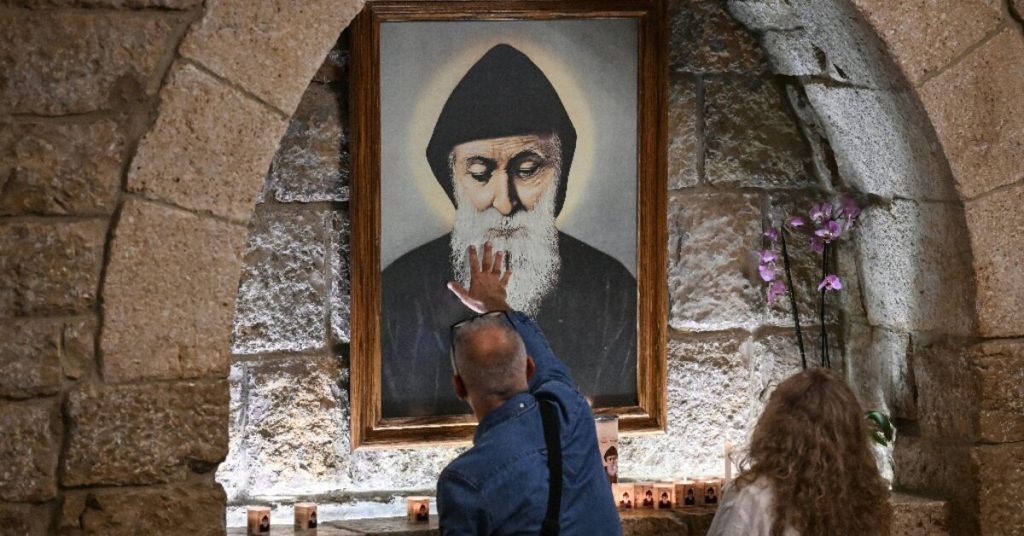The anticipation is building in Lebanon as the country prepares to welcome Pope Leo XIV on his first international trip since assuming the papacy. Central to this visit is the planned pilgrimage to the monastery of Saint Charbel Makhlouf in Annaya, a location revered not only by Christians but by people of all faiths who attribute miraculous healings to the saint’s intercession. Stories of Saint Charbel’s miracles deeply resonate with Lebanese people, and his upcoming visit with the Pope amplifies the feeling of hope amidst a period of unprecedented challenges.
A Legacy of Faith and Healing: Saint Charbel’s Enduring Impact
Youssef Makhlouf, known globally as Saint Charbel, was born in 1828 in a small village in North Lebanon. He joined the Lebanese Maronite Order at the age of 23 and dedicated his life to prayer and solitude at the Saint Maron Monastery in Annaya. His ascetic lifestyle and profound piety quickly garnered respect and attracted those seeking spiritual guidance. He passed away in 1898 and was canonized as a saint by Pope Paul VI in 1977.
However, the story of Saint Charbel didn’t end with his death. In 1950, his tomb was opened revealing his remarkably preserved body – a phenomenon widely regarded as a divine sign. This event solidified his status as a powerful intercessor, and accounts of miracles attributed to his prayers began to proliferate. These miracles range from physical healings to emotional and spiritual transformations, attracting pilgrims from across the globe.
Personal Testimonies: “He Saved My Life”
The belief in Saint Charbel’s power transcends religious boundaries. Charbel Matar, a 69-year-old pilgrim, recounted a deeply personal story. “My family and I have great faith in Saint Charbel and always visit him,” he stated at the monastery. Matar shared that he was near death as a five-year-old child, but his parents fervently prayed to Saint Charbel, believing in divine intervention. In a testament to their faith, they even renamed him Charbel in honor of the saint, and Matar attributes his continued life – 64 additional years – to Saint Charbel’s miraculous intervention.
Randa Saliba, 60, articulated the sentiments of many. “Saint Charbel is a message of love… and the face of Lebanon,” she said, visiting the monastery with her family. She emphasized the importance of the Pope’s visit to the tomb, seeing it as a sign of hope and a reaffirmation of their faith. Many see Saint Charbel as providing spiritual solace and practical help in navigating life’s difficulties.
The Pope’s Pilgrimage: A Beacon of Hope for Lebanon
Pope Leo XIV’s journey to Lebanon comes at a crucial moment. The country has been grappling with a severe economic crisis since 2019, a devastating explosion at the Beirut port in 2020, and ongoing political instability. While a ceasefire between Israel and Hezbollah technically ended hostilities in November 2024, tensions remain high, and the fear of renewed conflict is palpable. The Pope’s visit, particularly his planned stop at Saint Charbel’s monastery, is seen as a powerful gesture of solidarity with the Lebanese people.
Preparations are underway to welcome the pontiff and the influx of pilgrims expected to accompany his visit. Roads leading to the monastery in Annaya are being renovated, and the site itself is being prepared to receive the large crowds. Interestingly, visitors already include individuals from all backgrounds, including Muslims wearing the hijab, demonstrating the widespread reverence for the saint within Lebanese society and beyond. The monastery receives an estimated three million visitors annually, a testament to Saint Charbel’s global appeal. Vice rector Tannous Nehme noted that these visitors originate from all corners of the world, including Africa, Europe, and Russia.
Miracles and Beyond: Saint Charbel as a National Symbol
The Catholic Church acknowledges the numerous reported miracles associated with Saint Charbel, documenting tens of thousands of cases of healing. One particularly famous example is that of Nohad al-Shami, who reportedly suffered from an incurable illness in 1993. According to her testimony, Saint Charbel appeared to her in a dream and granted her healing. Though she passed away earlier this year, her story continues to inspire faith.
However, the significance of Saint Charbel’s tomb goes beyond miraculous healings. He has become a powerful national symbol for Lebanon, embodying resilience, faith, and hope in the face of adversity. Images of the saint, typically depicted with his iconic white beard, prayerful gaze and dark robes, are ubiquitous throughout the country, adorning homes, vehicles, and workplaces.
A Call for Renewal & Optimism
The Pope’s visit, building upon similar journeys by Popes Benedict XVI and John Paul II, is expected to inject new energy and spiritual revitalization into Lebanon. Pope Leo XIV’s meetings with Lebanese officials, including President Joseph Aoun, a Maronite Christian, signal a commitment to supporting the country’s unique political and religious landscape.
Claude Issa, a mother of three, aptly summarized the prevailing sentiment. “The Pope’s visit is very important for Lebanon. It brings goodness and blessings… and optimism for the Lebanese people.” The hope is that his presence will not only comfort the suffering but also inspire a renewed sense of purpose and a belief in a brighter future for Lebanon. The pilgrimage to Saint Charbel’s monastery is destined to be a focal point of this journey, a symbol of faith, and a beacon of hope for a nation in need of both.

